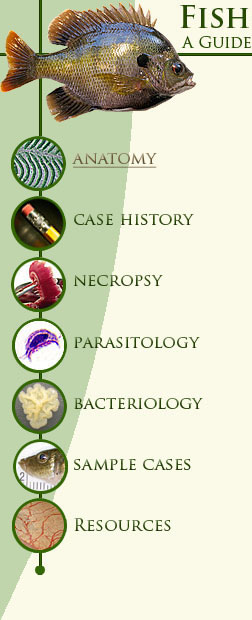Much can be learned about various fishes by making observations about their morphology. The following information will highlight four ways to gain insights about how different fishes interact with their environment. Examining the position of the mouth, shape of the fins, length of the gut, and gill racker morphology, can reveal some of what the fish does for a living.
|
Fin Shape
The shape of the fin can be an indication of feeding and movement styles of a fish. In the two following examples, flying fish and sturgeon, the tail (caudal fin) proves to play a big role in eating habits and unique movement abilities.
|
Extended upper lobe of fin (European sturgeon)
|
Extended Lower Caudal Lobe: Flying Fish
|
This European sturgeon has an elongated upper caudal lobe. This attribute aids in propelling the fish downward for feeding. The inferior mouth orientation allows for bottom feeding which is common for this species. Click here for a picture of this mouth.
In the photograph below, note that fin shape is responsible for aerial flight. The paired pectoral fins extend out allowing the fish to glide and gain altitude while the extended lower lobe of its caudal fin propels it forward and helps to provide lift.
|
Flying fish have an extended caudal fin lower lobe. This attribute helps to propel the fish upward toward the surface of the water (and out of the water). Elongate pectoral fins serve as functional wings to sustain lift. Great apparatus to avoid a predator from below! |
|
|
Orientation of mouth
The position of the fish's mouth can reveal a lot about the eating style of the fish. If the direction the mouth opens is directly in front of the fish, or terminally, it's prey or food items are likely available in the open water, direcly in front of them. If the mouth is oriented upward, or with a superior orientation the fishes diet will be consistent with what can be found at the surface of the water. Likewise, if the orientation is in a downward (sub-terminal) position, food items are likely found below the fish. |
Terminal orentation: Brook trout
Superior Orientation: Mosquitofish
This mosquitoifish is feeding on mosquito larvae at the water surface. It's mouth has a superior orientation which allows it to access food that is located above it's longitudinal body axis.
|
Inferior Mouth Orientation: European sturgeon
Subterminal Orientation: Carp
Carps have a subterminal mouth that facilitates feeding off of the bottom.
|
Guts
The gut length of a fish will have adapted to the needs of that fish based on its diet. The longer the tract, the more surface there is for absorption. A fish that has a diet primarily consisting of plants will need more time, surface area, to breakdown the cellulose of the plant cells. The fish that eat only meat will need a much shorter trast as the breakdown of meat is a relatively short process. The following pictures will show these different gut types.
|
|
Carnivorous fishes typiclly have a short and relatively straight gut. |
|
|
Omnivorous fishes will typically have a slightly longer, intermediate length gut, with a "J" shaped stomach. |
|
|
Herbiverous fishes tend to have a relatively long and convoluted gut to aid in digestion of ingesta with cellulose cell walls. |
Gill Rakers
Gill rakers are an anatomical feature of fish that aid in the gathering of food and protection of the gills. The rakers are located inside the oral cavity and point anteriorly from their attachment to the gill arch.
The oral cavity of an oyster toadfish is pictured on the right. The small finger-like projections from the gill arches seen at the back of the oral cavity, to either side of the esophagus, are the gill rakers. These rakers are short and stout, protecting this fish's gills as it takes in a variety of prey items, e.g., crustaceans, squid, mulloscs, or other fish. |
|
| The two pictures above show gill arches with gill filaments and gill rakers from the planktiverous Atlantic menhaden (left) and carniverous striped bass (right). Gill rakers on the menhaden are long, fine, almost hair-like projections from the gill arch. Like baleen in a mysticete whale, these gill rakers strain the water for algae and other plankton. In contrast, the comparatively heavy-duty gill rakers of the striped bass aid in holding and swallowing pray, and protecting the delicate gill filaments from larger prey items. |
|
|


